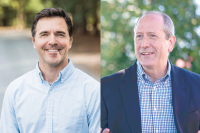One fateful night
The Turnaround by George Pelecanos. Little, Brown and Company, 2009. 320 pages
On a sweltering summer night in 1972, three white teenagers in Washington, D. C., decide to cruise through a black neighborhood called Heathrow Heights. On a dare, the driver, Billy Cachoris, yells a few racial slurs at three black teenagers while his companion, Pete Whitten, throws a cherry pie. Alex Pappas, the third teenager, is in the back seat and does not participate in this dangerous prank. Belatedly, Cachoris discovers that he is in a turnaround with no exit. His only choice is to turn around and go back to where three very angry blacks stand in the middle of the street waiting. Billy stops the car, gets out and attempts to apologize. He is sucker-punched and while he is lying in the street, he is shot in the back. Pete jumps from the car and runs. Alex is badly beaten and scarred for life.
George Pelecanos, who calls The Turnaround his most autobiographical novel, provides extensive information about the three black teenagers. James and Raymond Monroe are brothers and both have recently heard their mother describe how she had been subjected to racial slurs by some white teenagers just a few nights earlier. Charles Baker, several years older than the Monroe brothers, has a reputation for violence and drugs. He strikes Billy Cachoris and attacks Alex Pappas, leaving him with mutilated eye (Alex says that he looks as though his damaged eyes is perpetually weeping.) A witness later testifies that one of the Monroe brothers fired the fatal hot. Eventually, James Monroe confesses and is charged with murder.
The Turnaround is about consequences. When Pelecanos moves the action forward 35 years, we discover that the lives of all of the participants in that tragic night in 1972 have been altered; the lives of numerous others (children, wives, relatives, etc.) are affected in varying degrees. The central character, Alex Pappas, had once planned to go to college, but ends up operating his father’s Greek diner. Alex is haunted by that night in Heathrow Heights, and he often wonders if he could have changed the outcome. He sees his role in the tragedy as an example of his role in life. He is “the guy in the backseat,” someone who is not really involved in the action, but sanctioning it with his silence.
Recently, his sense of being powerless to shape his life has been intensified by the death of his own son in Iraq. James Monroe does not fare well in prison and ends up serving a total of 20 years. Out of prison, he drinks too much and ekes out a living as an underpaid mechanic. Charles Baker, who had testified against James Monroe in the trial in exchange for a light sentence, has become a hardened petty criminal who preys on the weak. Only Pete Whitten, a local WASP from a privileged family, and now a local lawyer; and Ray Monroe, who works in a military rehabilitation center assisting maimed veterans; and Alex Pappas have managed to create meaningful and economically secure lives complete with wives and children.
Related Items
When a chance meeting between Alex Pappas and Ray Monroe occurs, Pelecanos handles this confrontation as a kind of moral “turnaround.” Thirty-five years after the tragedy of Heathrow Heights, all of the survivors find themselves facing a personal crisis. Alex feels that he has sacrificed his personal dreams for the benefit of his family; Ray Monroe has lead a fulfilling life of service to others, but is haunted by guilt (he harbors a secret about the death of Billy Cachoris); James Monroe, trapped in a dead-end job, a tendency to drink too much and an inability to make friends, has unwittingly become involved with Charles Baker in an extortion scheme. Finally, there is Charles Baker, who bitterly resents the material wealth of everyone and spends much of his time developing schemes to take advantage of others. Unfortunately, one of his plans involves taking control if a lucrative drug operation run by a syndicate of ruthless dealers.
The Turnaround represents yet another example of a “new theme” in the recent works of George Pelecanos. Many of his earlier novels (Down Where the Dead Men Go, Shoedog, A Firing Offense) although skillfully written are noted for their darkness and brutality. In recent years, a new theme has emerged in works such as The Night Gardener, Drama City and Hard Revolution: the theme of redemption. In recent works, Pelecanos develops characters who find meaningful lives through family, sacrifice and work. Indeed, this is the trinity that dominates in The Turnaround.
In the latter part of The Turnaround, there are two significant confrontations: the chance meeting between Raymond Monroe and Alex Pappas, which evolves into a series of meetings in which these two men strive to find a way to bring closure to the bitterness and resentment that both parties have harbored for 35 years. It is through the initiative of Pappas that the two factions finally merge in the creation of “a project” that will redeem them all. The second significant confrontation is between Charles Baker and Pete Whitten (and later repeated between Baker and Alex Pappas) and is tainted by Baker’s use of threat and intimidation. In the final analysis Baker’s schemes are counterproductive, and, produce yet another tragedy.
What is interesting about this change in themes in Pelecanos’ novels is his passionate presentation of the redeeming aspects of family, work and sacrifice. In The Turnaround, Alex Pappas and Raymond Monroe survive because of them. Characters (like Charles Baker), who are without family or meaningful work are often doomed. For several years now, Pelecanos has been active in book-signing circuit, and he frequently delivers lectures to his fans that resemble fervent sermons. (See Pelecanos on YouTube.)
No review of a Pelecanos novel would be complete without acknowledging the author’s remarkable ability to capture and/or encapsulate the atmosphere of a specific time and place. With Pelecanos, it is Washington, D. C., and the area around Dupont Circle, circa 1970. The Turnaround resonates with crisp dialogue that contains vivid references to that era’s music, sports, radio personalities and popular cars. Many reader may relish the feeling of cruising through D.C. in a Monte Carlo listening to Wilson Pickett do “In the Midnight Hour” on WOL. I agree with Alex that, compared to what is now on the radio, those were good times.









